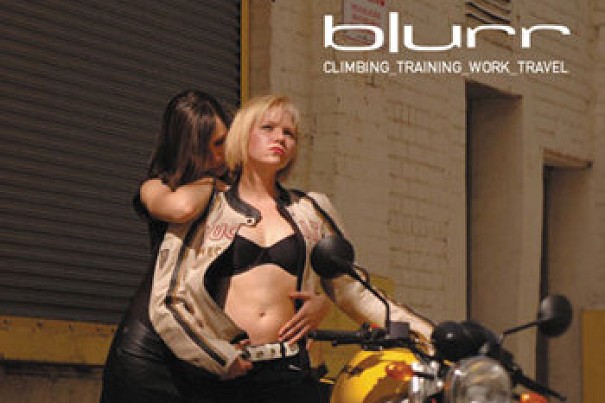
Climb Like A Girl Climb Like a Girl - Part 4
In this 4th part of Climb Like A Girl, Mick Ryan focuses on a single controversial advertising campaign by the US outdoor clothing retailer Blurr and looks at how this campaign was received.
Frequent UKC and Rocktalk contributor Mick Ryan has been a long term resident of the US since the early 90s. He spent many years living in Bishop California and was heavily involved in the recent boom in climbing, and especially bouldering, in the area. In this first of a four part article, Mick takes a look at the position of women in climbing today.
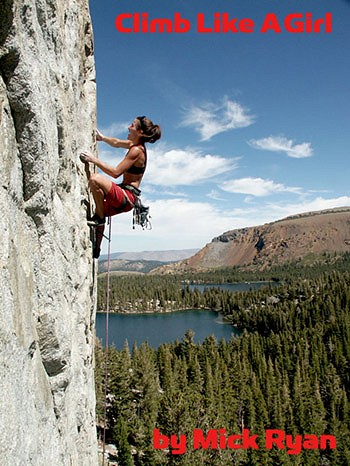
Buttermilk Stem is a fun problem, its start is hard to work out but simple to execute. To the chagrin of many climbers, it has a low grade. Near the end of a long session we all completed this problem, the climbing after the puzzling start is a fun big hold romp, not high by the Milks' standards but high enough to double check that you have set your feet properly on the grainy quartz-monzonite. It was a nipple-popping winter afternoon at Bishop's Buttermilk. The clouds were battleship gray, the jagged snow-covered Sierra Nevada loomed above us to the west and the first flurries of snow were whipping the valley bottom. There was a mixed bunch of us out, our bodies cacooned in layers trying to find sanctuary from the shark-tooth biting cold but finding more warmth from our friendship and our shared love of the dreamland that is the Eastern Sierra.
To the left of the Buttermilk Stem is a vertical grainy wall starting by a jump to a porthole then long reaches left between grainy just-edges that tested the limits of us all, even V-ten Tim had problems. Sarah cruised it despite just coming off the late shift at the Whiskey Creek bar and restaurant. Brian "Bone Daddy" Khul, a teacher, got it after several attempts, as did Krista, another teacher and mother of Brody who was at home this afternoon being looked after by dad. Grade? Oh I don't know, V4 or 5-ish. Something like that. I've never been one to obsess about how hard a guidebook writer thinks a problem is. Tim, optimistically suggested we link the sit-down start to the Buttermilk stem into this un-named problem. By now our tips were sand-papered down to raw meat and our biceps were burnt to ashes. Our minds may have been willing, but this new challenge was a whole different kettle of fish, more suited to Sharma than a bunch of employed but enthusiastic climbing bums. You know what happens next? You try, half-heartedly, you inevitably fail, you've had enough, it's time to leave, drink beer and discuss the meaning of life whilst watching the high winds whipping the snow off the ridges 10,000ft above. Nearly but not quite, Sarah Schneider hung back a little, taping the beta from our repeated failed attempts and in a concentrated effort worthy of a martial arts master focussed her way up what we could not. We never did decipher the meaning of life, the beer tasted as good as always, and Sarah had an extra one.
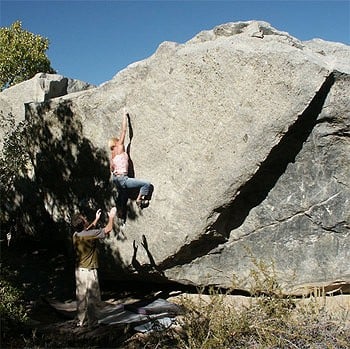
Nothing unusual you might think, just another days climbing in the 21st century. But run the tape back twenty years. I 'm not the only one who can remember when climbing was male-dominated? Mixed sex teams at the crag were rare and if a woman was at the crag she was more often than not being 'taken' climbing by her boyfriend. It was even rarer to get well and truly burnt off by a 'mere' girl. In the late 70's and early 80's the climber chick - climber chap dynamic was lob-sided.
You never take Sarah Schnieder climbing. She's not one of the "superwomen" climbers like Lynn Hill or Beth Rodden. Like most climbers she holds down a full time job, climbs as often as she can and goes on road trips to Joshua Tree or Moab or Red Rocks when she can get extended time off. She's independent in many respects, financially, politically and she's more likely to be found with a group of mates, both male and female when out climbing than being permanently attached to a partner.
She was to me representative of many women climbers in the USA that I used to meet at the climbing areas around the Sierra Nevada near Bishop, California. Whether I was sport climbing in the Owens River Gorge, bouldering at the Happy Boulders or hiking up the Mountaineers Trail to the East Face of Mount Whitney there were always women: alone, in women-only or mixed groups or with male partners. Girls who climb, if you haven't noticed, are on the ascendance. They are participating in the climbing world as never before, at the crags, down the gym, appearing in the magazines in greater numbers. Many of them, performance-wise, are up there playing in the first division, and an increasing number have joined the top boys in the premier league.

Lizzy Scully, founder and publisher of She Sends, a new magazine for women climbers, estimates that women make up between 20 and 30% of US climbers. That's 1 in 5 or just a bit more. So how many women climbers are there in the US? To know that you have to know how many climbers there are in the US and that is always a nebulous figure. Optimistic outdoor industry trade reports have stated 8 million but as industry insider Clyde Soles says that is a "....fantasy figure, nobody believes it. It's based on a survey of 15,000 people, where each person is supposed to represent 17,000+ other people in the US. Out of that 15,000, 500 said they have climbed on an artificial wall at least once in the last year, this includes walls on cruise ships and at state fairs". He continues, "for perspective, total sales of all rock shoes in the US last year was under 300,000 pairs." Even at that somewhat conservative figure, and if you believe Scully's estimate that would put the number of women climbers in the US between 60 to 90,000.
But hold on, a new climbing magazine dedicated to women? I asked Lizzy Scully why a women's climbing mag?
"Because they want one. The mainstream climbing magazines focus primarily on the women who are climbing really hard. She Sends includes stories about the everyday women climbers. All I hope for is to give women a chance to envision an alternative lifestyle, even if they don't turn into a strong woman or dirt-bag vagabonds, I think they enjoy just knowing that other women are out there doing cool things."
"Has there been any negative reaction to She Sends?" I asked.
"There's a few young women who are "anti-women's empowerment". Most men understand it's not about bashing men, but rather about celebrating women. Men celebrate women too."
Another new development is women-only climbing courses from wilderness seminars to beginners days. Perhaps the two that get the most press are Chicks With Picks (a woman's ice climbing meet founded by Kim Reynolds and now exported to the UK) and Utah's Chicks On Cracks produced by Lisa Hathaway and Emma Medara. The theory is that these women-only events and clinics provide a friendly environment were women can learn from each other and experienced women climber mentors.
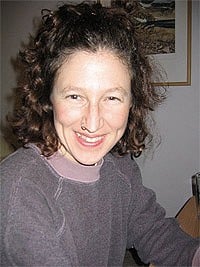
Women have mixed feelings about these events. I asked Kellie McBee, a well-travelled climber from Washington State her opinion, " I think a lot of women-only events suffer from cant about "empowerment" and "overcoming the male paradigm" and "supportive environment" stuff. That sort of jargon turns me off. I much prefer learning by going out and trying stuff with one or two people." Kristen McNamara from San Luis Obispo and a writer for rockclimbing.com feels the same "I think they can be a good thing if that's your bag. Some women are more comfortable being 'empowered'. I find my empowerment through pushing myself to not be categorized as a "woman climber" and simply a "climber". But some, especially those who have been on these events, think differently. Elyse Brandt a new climber from San Diego attended Chicks On Cracks this past November, "I was a wee bit apprehensive that it was going to be a "wimmin power" estrogen-fest. The reality of the event was that it was a great weekend with great women. No one talked about paradigms or being just as good or better than men. It was just a women doing something they like."
Whilst I was writing this article Outside magazine (April 2005 issue) ran a cover article on "women of rock" entitled " Babes on belay", documenting the climbing roadtrip of four 24 year climbers from New Hampshire written by San Francisco writer/climber Elizabeth Weil. If a mainstream outdoor recreation magazine like Outside are taking notice you can bet that something is afoot.
Gear For Girls
Whether you believe the amateur statistics, the obvious signs in the print media or like many you have just noticed more women climbers at the crag the increase in women climbers the last fifteen years or so is not in doubt and it certainly hasn't been ignored by climbing equipment and clothing manufacturers. Women are anatomically different than men. "Duh", I hear you say, "of course they are", but its not just their breasts and as Emma Medara once said "a beautifully packaged reproductive equipment with no external parts." Women's feet are different. They have lower volume heels, lower ankle bones, and higher arches. They have shorter lower legs, smaller waists, wider hips, narrower shoulders, smaller hands, longer necks, smaller eye sockets. Virtually every outdoor equipment manufacturer now recognizes these differences and has a woman's line and not just men's gear in "girly" colors. From glacier goggles to ice axes, luna bars to rock shoes to harnesses, women can purchase gear specially designed and styled for them, and often purchase them from woman's only retailers. A special mention must be made of the single most important innovation of late 20th century climbing, the sport bra, but I would say that wouldn't I?
The difference between men and women, both physically and mentally has led many a man to state that women will never climb as hard as men. They're too short, not as strong, lack the motivation, get scared too easily. It is almost as if some men think that they posses some monopolistic evolutionary advantage when it comes to climbing. As Weil said in her Outside article, "Climbing is a nearly perfect sport for women, one in which balance, finesse, and strength-to-weight ratio are more important than stand-alone power or speed." Do you think that women aren't as aggressive as men? Consider that some anthropologists consider that it is only recently that some women have lost touch with their "predator nature" and fallen into a culturally-designated role as "gatherer" and "keeper of the hearth". As Don Whillans is reported to have once said, "Never noticed a female monkey not climbing as well as a male, have you?" and women are proving it.
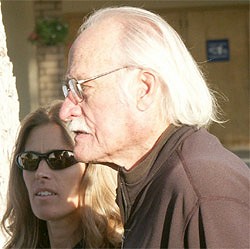
It Goes Boys!
The Basque climber, Iker Pou, a little climber with little fingers, has repeated Gullich's Action Directe a 5.14d, the 5.14a version of El Cap's El Nino and boulders V-ridiculous but despite a serious attempt last fall he did not manage to repeat Lynn Hill's free ascent of El Cap's Free Nose.
"It goes boy's" Hill said after her landmark ascent eleven years ago, but still the boys, and some very talented boys, have failed to free the Great Roof and Changing Corners pitches. Hill has been climbing at the highest levels (5.12+ and up to 5.14) since the 80's and she is often cited as an example of a woman climbing as hard as some men, but often the backlash kicks in and it whispered that she is an anomaly. Although the 1970's Yosemite climber, Roger Breedlove, does perhaps echo the majority view when he says that "I think Lynn Hill is the perfect example of what everyone should aspire to, male or female.
Even the so-called gym-bred generation are producing their own superstars. Beth Rodden is a fine example of someone who has shattered the myth and conventional wisdom that indoor climbers stay indoors and only venture outside to fall two-feet onto a bouldering cushion or sag an inch onto a meaty bolt, and increasingly she is not the exception. Rodden has just climbed the first ascent of The Optimist 5.14b at Oregon's, Smith Rock. Just prior to this ascent she free-climbed the multi-pitch Grand Wall 5.13b at Squamish in Canada building on experience gained by climbing several free El Cap routes, such as the Salathé and Lurking Fear with her husband Tommy Caldwell. Also in her quiver are a diverse list of highly sought-after sport and traditional climbs including To Bolt or Not To Be 5.14, The Phoenix 5.13a and Tony Yaniros' overhanging crack, The Grand Illusion 5.13a/b. If you want bold watch Lisa Rands in her DVD The Hit List, a frequent visitor to the UK, Rands is one of the boldest climbers you will ever meet. She takes frequent flyers from great height like some knock back expressos in the morning. She has bouldered V12 and has combined her technical prowess with her boldness to headpoint hard grit routes, her recent ascent of End of the Affair, an early gritstone chop-route climbed by the madcap Englishman Johnny Dawes, being the pick of the crop.
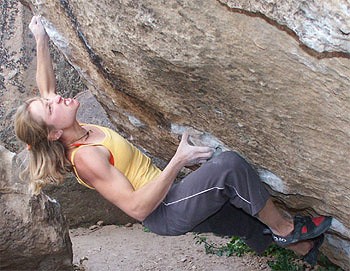
On alpine rock, ice, sport climbs, big walls and trad, women climbers are making the climbing headlines in numbers never seen before, many of them climbing far harder than 99% of male climbers. You are no doubt familiar with Steph Davis, Heidi Wirtz, Robyn Erbesfield, Nancy Feagin, Sue McDevitt, Kitty Calhoun, Sue Nott, Eliza Sprecher, Katie Brown, Cicada Jenerik, Natasha Barnes, and Kim Csizmazia from mixed ice to long hard and free in Yosemite, from 10 year olds climbing V10 to 13 year olds climbing 13b, these women, and many more, are leading the third wave in US woman's climbing.
The first wave washed quietly against the shores over 80 years ago when the late Miriam Underhill, who was born in Washington DC, climbed extensively in the European Alps in the 1920's and 30's. She did the first woman only ascent of the Matterhorn with Alice Damesme, was first woman to traverse of the Grepon, and with her husband Robert Underhill did the first complete traverse of the Aiguille du Diable. Miriam Underhill is credited with bringing "manless" and "guideless" climbing with her woman-only ascents.
In the post-war years Freddy Hubbard and Mary Sherrill of the Stanford University Alpine Club were making regular climbing trips to Yosemite climbing the Higher Spire in 1947, and Hubbard went on to lead of Washington Column's strenuous Direct Route (5.7). They paved the way for Bea Vogel to become the first "certified" leader of Stanford's Alpine Club and the history of women climbers in Yosemite had begun, although as we shall see later it was in the socially turbulent Sixties that women joined the dirt vagabonds in Camp 4 en masse.
At the same time Jan Conn, although not widely known, was a driving force in woman's climbing. She climbed with her husband Herb and they climbed significant ascents all over the US but it was in the Needles of South Dakota where she really made her mark. Climbing in Keds (light-canvass sneakers), with short lengths of goldline rope, soft-steel pitons and the odd hand-drilled quarter inch bolt, they made hundreds of first ascents up the endless spires of the Black Hills of South Dakota. The Gunks climber Rich Goldstone who bouldered in the Black Hills with John Gill in the late sixties remembers, "Many of their leads were very run out, especially by the standards of the day. In modern terms they got up to 5.8+ (on the East Face of the East Gruesome in 1959) and 5.7 X. They downclimbed everything they climbed up - with toprope protection on the harder routes rather than rappelling. That 5.8+, by the way, is fully the equivalent of 5.9 routes at Tahquitz,"
Goldstone continues "This meant that Jan was, in her day, one of the better climbers in the country, regardless of gender, and certainly deserves a position of honor in the pantheon of the country's women climbers"

Comments